Visualization of Post-Fire Remote Sensing Using CiteSpace: A Bibliometric Analysis
Abstract
1. Introduction
2. Data and Methodology
2.1. Data Collection and Search Strategies
2.2. Analytical Methods
3. Results and Discussion
3.1. Publications and Annual Growth
3.2. Subject Area Distribution
3.3. Core Journals and Literature
3.4. Core Authors
3.5. Countries and Institutions
3.6. Keywords
- (1)
- Forest types and wildfires: “boreal forest”, “rim fire”, and “forest fires”. Much post-fire remote sensing research focuses on specific regions or well-known wildfire events [53,54]. Boreal forests are primarily located in the high latitudes of the Northern Hemisphere, characterized by significant carbon stocks and prominent permafrost features. Consequently, fires in these regions can profoundly affect regional and even global carbon cycles [55]. “Forest fires” refers to wildfire disturbances across diverse forest ecosystems. As climate change and human activities intensify, the extent and frequency of forest fires continue to rise, prompting widespread concern [56];
- (2)
- Technical support: “remote sensing”, “Google Earth Engine”, “machine learning”. This category direct reflects the rapid evolution in data and methods of post-fire research in recent years, emphasizing the new opportunities that the era of big data brings to post-fire remote sensing. Compared with conventional threshold-based or linear regression methods, ML can exploit multi-source data features more comprehensively, facilitating a more accurate prediction and spatiotemporal modeling of post-fire recovery or fire dynamics. It also captures the complexity of ecological regeneration under multiple disturbance scenarios more effectively, thus attracting significant interest [57,58];
- (3)
- Fire evaluation: “burn severity” and “fire severity”. This category shows the core effort in quantitatively assessing wildfire impacts in fire science, further developing multi-perspective, interdisciplinary academic discourse. Both keywords in this group concentrate on quantifying the level of destruction inflicted on vegetation, soil, and related components by fire [59]. These indicators encompass more than just the extent of burned area, instead focusing on a comprehensive quantitative appraisal of ecosystem function and structure (e.g., canopy damage, soil nutrient depletion, sur-face hydrological alterations) [60]. Consequently, the research pathway of fire assessment indicators extends naturally into post-fire forest restoration management, climate adaptation strategies, and the maintenance and rehabilitation of ecosystem services [61];
- (4)
- Fire and ecosystems: “climate change” and “erosion”. With global warming and an increase in extreme weather events, the frequency and intensity of wildfires generally escalate, leaving post-fire recovery to contend with a more uncertain climatic background [62]. Following a wildfire, vegetation cover declines abruptly and soil structure deteriorates; combined with intense rainfall or snowmelt, this can trigger severe soil erosion and the loss of soil resources. The decline in soil carbon and nutrients not only prevents subsequent vegetation regeneration but may also compound sediment build-up in water bodies, thus degrading their water quality [63]. Evidently, fire ecology research is increasingly underscoring the multi-medium interplay of “fire–water–soil–atmosphere”, prompting a convergence of hydrology, geomorphology, ecology, and various other fields.
3.7. Basic Situation of Research in the Field of Post-Fire Remote Sensing
3.8. Prospects for Post-Fire Remote Sensing Research
3.9. Limitations
4. Conclusions
Author Contributions
Funding
Institutional Review Board Statement
Informed Consent Statement
Data Availability Statement
Conflicts of Interest
References
- Loydi, A.; Funk, F.A.; García, A. Vegetation Recovery after Fire in Mountain Grasslands of Argentina. J. Mt. Sci. 2020, 17, 373–383. [Google Scholar] [CrossRef]
- Celis, N.; Casallas, A.; Lopez-Barrera, E.A.; Felician, M.; Marchi, M.D.; Pappalardo, S.E. Climate Change, Forest Fires, and Territorial Dynamics in the Amazon Rainforest: An Integrated Analysis for Mitigation Strategies. ISPRS Int. J. Geo-Inf. 2023, 12, 436. [Google Scholar] [CrossRef]
- Sintayehu, D.W. Impact of Climate Change on Biotdersity and Associated Key Ecosystem Services in Africa: A Systematic Review. Ecosyst. Health Sustain. 2018, 4, 225–239. [Google Scholar] [CrossRef]
- Liu, Y.; Goodrick, S.; Heilman, W. Wildland Fire Emissions, Carbon, and Climate: Wildfire–Climate Interactions. For. Ecol. Manag. 2014, 317, 80–96. [Google Scholar] [CrossRef]
- Abram, N.J.; Henley, B.J.; Gupta, A.S.; Lippmann, T.J.R.; Clarke, H.; Dowdy, A.J.; Sharples, J.J.; Nolan, R.H.; Zhang, T.; Wooster, M.J.; et al. Connections of Climate Change and Variability to Large and Extreme Forest Fires in Southeast Australia. Commun. Earth Environ. 2021, 2, 8. [Google Scholar] [CrossRef]
- Hao, B.; Xu, X.; Wu, F.; Tan, L. Long-Term Effects of Fire Severity and Climatic Factors on Post-Forest-Fire Vegetation Recovery. Forests 2022, 13, 883. [Google Scholar] [CrossRef]
- Kurbanov, E.; Vorobev, O.; Lezhnin, S.; Sha, J.; Wang, J.; Li, X.; Cole, J.; Dergunov, D.; Wang, Y. Remote Sensing of Forest Burnt Area, Burn Severity, and Post-Fire Recovery: A Review. Remote Sens. 2022, 14, 4714. [Google Scholar] [CrossRef]
- Shvetsov, E.G.; Kukavskaya, E.A.; Buryak, L.V.; Barrett, K. Assessment of Post-Fire Vegetation Recovery in Southern Siberia Using Remote Sensing Observations. Environ. Res. Lett. 2019, 14, 055001. [Google Scholar] [CrossRef]
- Pérez-Cabello, F.; Montorio, R.; Alves, D.B. Remote Sensing Techniques to Assess Post-Fire Vegetation Recovery. Curr. Opin. Environ. Sci. Health 2021, 21, 100251. [Google Scholar] [CrossRef]
- Mallinis, G.; Mitsopoulos, I.; Chrysafi, I. Evaluating and Comparing Sentinel 2A and Landsat-8 Operational Land Imager (OLI) Spectral Indices for Estimating Fire Severity in a Mediterranean Pine Ecosystem of Greece. GIScience Remote Sens. 2017, 55, 1–18. [Google Scholar] [CrossRef]
- Lai, R.; Oguchi, T.; Zhong, C. Evaluating Spatiotemporal Patterns of Post-Eruption Vegetation Recovery at Unzen Volcano, Japan, from Landsat Time Series. Remote Sens. 2022, 14, 5419. [Google Scholar] [CrossRef]
- Priya, R.S.; Vani, K. Vegetation Change Detection and Recovery Assessment Based on Post-Fire Satellite Imagery Using Deep Learning. Sci. Rep. 2024, 14, 12611. [Google Scholar] [CrossRef] [PubMed]
- Seydi, S.T.; Hasanlou, M.; Chanussot, J. Burnt-Net: Wildfire Burned Area Mapping with Single Post-Fire Sentinel-2 Data and Deep Learning Morphological Neural Network. Ecol. Indic. 2022, 140, 108999. [Google Scholar] [CrossRef]
- Yang, H.; Shao, X.; Wu, M. A Review on Ecosystem Health Research: A Visualization Based on CiteSpace. Sustainability 2019, 11, 4908. [Google Scholar] [CrossRef]
- Chen, C.; Song, I.-Y.; Yuan, X.; Zhang, J. The Thematic and Citation Landscape of Data and Knowledge Engineering (1985–2007). Data Knowl. Eng. 2008, 67, 234–259. [Google Scholar] [CrossRef]
- Zhu, Y.-D.; Shao, T.-J.; Wang, Y.-H.; Wang, R.-Y. Review and Future Trends of Soil Microplastics Research: Visual Analysis Based on Citespace. Environ. Sci. Eur. 2022, 34, 122. [Google Scholar] [CrossRef]
- Sun, H.; Zhang, X.; Ruan, X.; Jiang, H.; Shou, W. Mapping Compound Flooding Risks for Urban Resilience in Coastal Zones: A Comprehensive Methodological Review. Remote Sens. 2024, 16, 350. [Google Scholar] [CrossRef]
- Jia, F.; Sun, D.; Looi, C. Artificial Intelligence in Science Education (2013–2023): Research Trends in Ten Years. J. Sci. Educ. Technol. 2023, 33, 94–117. [Google Scholar] [CrossRef]
- Chen, C. Searching for Intellectual Turning Points: Progressive Knowledge Domain Visualization. Proc. Natl. Acad. Sci. USA 2004, 101, 5303–5310. [Google Scholar] [CrossRef]
- Chen, C.; Song, M. Visualizing a Field of Research: A Methodology of Systematic Scientometric Reviews. PLoS ONE 2019, 14, e0223994. [Google Scholar] [CrossRef]
- Bourgeau-Chavez, L.L.; Kasischke, E.S.; French NH, F.; Szeto, L.H.; Kherkher, C.M. Using ERS-1 SAR Imagery to Monitor Variations in Burn Severity in an Alaskan Fire-Distributed Boreal Forest Ecosystem. In Proceedings of the International Geoscience and Remote Sensing Symposium on Surface and Atmospheric Remote Sensing—Technologies, Data Analysis and Interpretation (IGARSS 94), Caltech, Pasadena, CA, USA; 1992; Volumes 1–4, pp. 243–245. [Google Scholar]
- Nel, E.M.; Wessman, C.A.; Veblen, T.T. Digital and Visual Analysis of Thematic Mapper Imagery for Differentiating Old Growth from Younger Spruce-Fir Stands. Remote Sens. Environ. 1994, 48, 291–301. [Google Scholar] [CrossRef]
- Tang, Z.; Zhang, T.; Wu, L.; Ren, S.; Cai, S. Knowledge Mapping for Fire Risk Assessment: A Scientometric Analysis Based on VOSviewer and CiteSpace. Fire 2024, 7, 23. [Google Scholar] [CrossRef]
- Yu, Y.; Shen, Y.; Liu, Y.; Wei, Y.; Rui, X.; Li, B. Knowledge Mapping and Trends in Research on Remote Sensing Change Detection Using CiteSpace Analysis. Earth Sci. Inform. 2022, 16, 787–801. [Google Scholar] [CrossRef]
- Zhang, J. Multi-Source Remote Sensing Data Fusion: Status and Trends. Int. J. Image Data Fusion 2010, 1, 5–24. [Google Scholar] [CrossRef]
- Wei, X.; Bai, K.; Chang, N.-B.; Gao, W. Multi-Source Hierarchical Data Fusion for High-Resolution AOD Mapping in a Forest Fire Event. Int. J. Appl. Earth Obs. Geoinf. 2021, 102, 102366. [Google Scholar] [CrossRef]
- Hart, S.J.; Henkelman, J.; McLoughlin, P.D.; Nielsen, S.E.; Truchon-Savard, A.; Johnstone, J.F. Examining Forest Resilience to Changing Fire Frequency in a Fire-prone Region of Boreal Forest. Glob. Change Biol. 2019, 25, 869–884. [Google Scholar] [CrossRef]
- Seydi, S.T.; Akhoondzadeh, M.; Amani, M.; Mahdavi, S. Wildfire Damage Assessment over Australia Using Sentinel-2 Imagery and MODIS Land Cover Product within the Google Earth Engine Cloud Platform. Remote Sens. 2021, 13, 220. [Google Scholar] [CrossRef]
- Parks, S.A.; Holsinger, L.M.; Voss, M.A.; Loehman, R.A.; Robinson, N.P. Mean Composite Fire Severity Metrics Computed with Google Earth Engine Offer Improved Accuracy and Expanded Mapping Potential. Remote Sens. 2018, 10, 879. [Google Scholar] [CrossRef]
- Kinoshita, A.M.; Hogue, T.S. Spatial and Temporal Controls on Post-Fire Hydrologic Recovery in Southern California Watersheds. CATENA 2011, 87, 240–252. [Google Scholar] [CrossRef]
- Boroujeni, S.P.H.; Razi, A.; Khoshdel, S.; Afghah, F.; Coen, J.L.; O’Neill, L.; Fule, P.; Watts, A.; Kokolakis, N.-M.T.; Vamvoudakis, K.G. A Comprehensive Survey of Research towards AI-Enabled Unmanned Aerial Systems in Pre-, Active-, and Post-Wildfire Management. Inf. Fusion 2024, 108, 102369. [Google Scholar] [CrossRef]
- McWethy, D.B.; Schoennagel, T.; Higuera, P.E.; Krawchuk, M.; Harvey, B.J.; Metcalf, E.C.; Schultz, C.; Miller, C.; Metcalf, A.L.; Buma, B.; et al. Rethinking Resilience to Wildfire. Nat. Sustain. 2019, 2, 797–804. [Google Scholar] [CrossRef]
- Chen, C. CiteSpace II: Detecting and Visualizing Emerging Trends and Transient Patterns in Scientific Literature. J. Am. Soc. Inf. Sci. Technol. 2006, 57, 359–377. [Google Scholar] [CrossRef]
- Liu, J.; Li, J.; Wang, J. In-Depth Analysis on Thermal Hazards Related Research Trends about Lithium-Ion Batteries: A Bibliometric Study. J. Energy Storage 2021, 35, 102253. [Google Scholar] [CrossRef]
- Chen, C.; Dubin, R.; Kim, M.C. Orphan Drugs and Rare Diseases: A Scientometric Review (2000–2014). Expert Opin. Orphan Drugs 2014, 2, 709–724. [Google Scholar] [CrossRef]
- Gibson, R.; Danaher, T.; Hehir, W.; Collins, L. A Remote Sensing Approach to Mapping Fire Severity in South-Eastern Australia Using Sentinel 2 and Random Forest. Remote Sens. Environ. 2020, 240, 111702. [Google Scholar] [CrossRef]
- Bright, B.C.; Hudak, A.T.; Kennedy, R.E.; Braaten, J.D.; Khalyani, A.H. Examining Post-Fire Vegetation Recovery with Landsat Time Series Analysis in Three Western North American Forest Types. Fire Ecol. 2019, 15, 8. [Google Scholar] [CrossRef]
- Fernández-García, V.; Santamarta, M.; Fernández-Manso, A.; Quintano, C.; Marcos, E.; Calvo, L. Burn Severity Metrics in Fire-Prone Pine Ecosystems along a Climatic Gradient Using Landsat Imagery. Remote Sens. Environ. 2018, 206, 205–217. [Google Scholar] [CrossRef]
- Collins, L.; Griffioen, P.; Newell, G.; Mellor, A. The Utility of Random Forests for Wildfire Severity Mapping. Remote Sens. Environ. 2018, 216, 374–384. [Google Scholar] [CrossRef]
- Huang, S.; Jin, S.; Dahal, D.; Chen, X.; Young, C.; Liu, H.; Liu, S. Reconstructing Satellite Images to Quantify Spatially Explicit Land Surface Change Caused by Fires and Succession: A Demonstration in the Yukon River Basin of Interior Alaska. Isprs J. Photogramm. Remote Sens. 2013, 79, 94–105. [Google Scholar] [CrossRef]
- Bolton, D.K.; Coops, N.C.; Hermosilla, T.; Wulder, M.A.; White, J.C. Assessing Variability in Post-fire Forest Structure along Gradients of Productivity in the Canadian Boreal Using Multi-source Remote Sensing. J. Biogeogr. 2017, 44, 1294–1305. [Google Scholar] [CrossRef]
- Miller, J.D.; Knapp, E.E.; Key, C.H.; Skinner, C.N.; Isbell, C.J.; Creasy, R.M.; Sherlock, J.W. Calibration and Validation of the Relative Differenced Normalized Burn Ratio (RdNBR) to Three Measures of Fire Severity in the Sierra Nevada and Klamath Mountains, California, USA. Remote Sens. Environ. 2009, 113, 645–656. [Google Scholar] [CrossRef]
- Miller, J.D.; Safford, H.D.; Welch, K.R. Using One Year Post-Fire Fire Severity Assessments to Estimate Longer-Term Effects of Fire in Conifer Forests of Northern and Eastern California, USA. For. Ecol. Manag. 2016, 382, 168–183. [Google Scholar] [CrossRef]
- Lutes, D.C.; Keane, R.E.; Caratti, J.F.; Key, C.H.; Benson, N.C.; Sutherland, S.; Gangi, L.J. FIREMON: Fire Effects Monitoring and Inventory System; US Department of Agriculture, Forest Service: Fort Collins, CO, USA, 2006. [Google Scholar] [CrossRef]
- Kolden, C.A.; Lutz, J.A.; Key, C.H.; Kane, J.T.; Wagtendonk, J.W. van Mapped versus Actual Burned Area within Wildfire Perimeters: Characterizing the Unburned. For. Ecol. Manag. 2012, 286, 38–47. [Google Scholar] [CrossRef]
- Ascoli, D.; Plana, E.; Oggioni, S.D.; Tomao, A.; Colonico, M.; Corona, P.; Giannino, F.; Moreno, M.; Xanthopoulos, G.; Kaoukis, K.; et al. Fire-Smart Solutions for Sustainable Wildfire Risk Prevention: Bottom-up Initiatives Meet Top-down Policies under EU Green Deal. Int. J. Disaster Risk Reduct. 2023, 92, 103715. [Google Scholar] [CrossRef]
- Wu, M.; Luo, J.; Huang, T.; Lian, L.; Chen, T.; Song, S.; Wang, Z.; Ma, S.; Xie, C.; Zhao, Y.; et al. Effects of African BaP Emission from Wildfire Biomass Burning on Regional and Global Environment and Human Health. Environ. Int. 2022, 162, 107162. [Google Scholar] [CrossRef]
- Kouassi, J.-L.; Wandan, N.; Mbow, C. Predictive Modeling of Wildfire Occurrence and Damage in a Tropical Savanna Ecosystem of West Africa. Fire 2020, 3, 42. [Google Scholar] [CrossRef]
- Ruggirello, M.J.; Bustamante, G.; Rodriguez, P.; Cruz-Alonso, V.; Soler, R. Post-Fire Forest Recovery at High Latitudes: Tree Regeneration Dominated by Fire-Adapted, Early-Seral Species Increases with Latitude. Ann. For. Sci. 2023, 80, 17. [Google Scholar] [CrossRef]
- Hu, L.; Zhu, H.; Liao, Q.; Qu, B.; Gao, R.; Tao, R.; Fu, M. Visual Analysis of Coal Fire Detection Research Based on Bibliometrics. Int. J. Remote Sens. 2023, 44, 5976–6011. [Google Scholar] [CrossRef]
- Tian, Y.; Wu, Z.; Li, M.; Wang, B.; Zhang, X. Forest Fire Spread Monitoring and Vegetation Dynamics Detection Based on Multi-Source Remote Sensing Images. Remote Sens. 2022, 14, 4431. [Google Scholar] [CrossRef]
- Jones, M.W.; Veraverbeke, S.; Andela, N.; Doerr, S.H.; Kolden, C.; Mataveli, G.; Pettinari, M.L.; Quéré, C.L.; Rosan, T.M.; van der Werf, G.R.; et al. Global Rise in Forest Fire Emissions Linked to Climate Change in the Extratropics. Science 2024, 386, eadl5889. [Google Scholar] [CrossRef]
- Lydersen, J.M.; North, M.P.; Collins, B.M. Severity of an Uncharacteristically Large Wildfire, the Rim Fire, in Forests with Relatively Restored Frequent Fire Regimes. For. Ecol. Manag. 2014, 328, 326–334. [Google Scholar] [CrossRef]
- Lentile, L.B.; Morgan, P.; Hudak, A.T.; Bobbitt, M.J.; Lewis, S.A.; Smith, A.M.S.; Robichaud, P.R. Post-Fire Burn Severity and Vegetation Response Following Eight Large Wildfires Across the Western United States. Fire Ecol. 2007, 3, 91–108. [Google Scholar] [CrossRef]
- Mekonnen, Z.A.; Riley, W.J.; Randerson, J.T.; Shirley, I.A.; Bouskill, N.J.; Grant, R.F. Wildfire Exacerbates High-Latitude Soil Carbon Losses from Climate Warming. Environ. Res. Lett. 2022, 17, 094037. [Google Scholar] [CrossRef]
- Williams, A.P.; Abatzoglou, J.T.; Gershunov, A.; Guzman-Morales, J.; Bishop, D.A.; Balch, J.K.; Lettenmaier, D.P. Observed Impacts of Anthropogenic Climate Change on Wildfire in California. Earth’s Future 2019, 7, 892–910. [Google Scholar] [CrossRef]
- Poon, P.K.; Kinoshita, A.M. Estimating Evapotranspiration in a Post-Fire Environment Using Remote Sensing and Machine Learning. Remote Sens. 2018, 10, 1728. [Google Scholar] [CrossRef]
- Jain, P.; Coogan, S.C.P.; Subramanian, S.G.; Crowley, M.; Taylor, S.; Flannigan, M.D. A Review of Machine Learning Applications in Wildfire Science and Management. Environ. Rev. 2020, 28, 478–505. [Google Scholar] [CrossRef]
- Keeley, J.E. Fire Intensity, Fire Severity and Burn Severity: A Brief Review and Suggested Usage. Int. J. Wildland Fire 2009, 18, 116. [Google Scholar] [CrossRef]
- Johnstone, J.F.; Chapin, F.S. Effects of Soil Burn Severity on Post-Fire Tree Recruitment in Boreal Forest. Ecosystems 2006, 9, 14–31. [Google Scholar] [CrossRef]
- Kokaly, R.F.; Rockwell, B.W.; Haire, S.L.; King, T.V.V. Characterization of Post-Fire Surface Cover, Soils, and Burn Severity at the Cerro Grande Fire, New Mexico, Using Hyperspectral and Multispectral Remote Sensing. Remote Sens. Environ. 2007, 106, 305–325. [Google Scholar] [CrossRef]
- Boucher, D.; Gauthier, S.; Thiffault, N.; Marchand, W.; Girardin, M.; Urli, M. How Climate Change Might Affect Tree Regeneration Following Fire at Northern Latitudes: A Review. New For. 2019, 51, 543–571. [Google Scholar] [CrossRef]
- Rust, A.J.; Hogue, T.S.; Saxe, S.; McCray, J. Post-Fire Water-Quality Response in the Western United States. Int. J. Wildland Fire 2018, 27, 203. [Google Scholar] [CrossRef]
- Li, Q.; Ahn, S.; Kim, T.; Im, S. Post-Fire Impacts of Vegetation Burning on Soil Properties and Water Repellency in a Pine Forest, South Korea. Forests 2021, 12, 708. [Google Scholar] [CrossRef]
- Zhao, Y.; Huang, Y.; Sun, X.; Dong, G.; Li, Y.; Ma, M. Forest Fire Mapping Using Multi-Source Remote Sensing Data: A Case Study in Chongqing. Remote Sens. 2023, 15, 2323. [Google Scholar] [CrossRef]
- Giannakidou, S.; Radoglou-Grammatikis, P.; Lagkas, T.; Argyriou, V.; Goudos, S.; Markakis, E.K.; Sarigiannidis, P. Leveraging the Power of Internet of Things and Artificial Intelligence in Forest Fire Prevention, Detection, and Restoration: A Comprehensive Survey. Internet Things 2024, 26, 101171. [Google Scholar] [CrossRef]
- Mauro, B.D.; Fava, F.; Busetto, L.; Crosta, G.F.; Colombo, R. Post-Fire Resilience in the Alpine Region Estimated from MODIS Satellite Multispectral Data. Int. J. Appl. Earth Obs. Geoinf. 2014, 32, 163–172. [Google Scholar] [CrossRef]
- Viana-Soto, A.; García, M.; Aguado, I.; Salas, J. Assessing Post-Fire Forest Structure Recovery by Combining LiDAR Data and Landsat Time Series in Mediterranean Pine Forests. Int. J. Appl. Earth Obs. Geoinf. 2022, 108, 102754. [Google Scholar] [CrossRef]
- Kominoski, J.S.; Fernandez, M.; Breault, P.; Sclater, V.; Rothermel, B.B. Fire Severity and Post-Fire Hydrology Drive Nutrient Cycling and Plant Community Recovery in Intermittent Wetlands. Ecosystems 2021, 25, 265–278. [Google Scholar] [CrossRef]
- Souane, A.A.; Khurram, A.; Huang, H.; Shu, Z.; Feng, S.; Belgherbi, B.; Wu, Z. Utilizing Machine Learning and Geospatial Techniques to Evaluate Post-Fire Vegetation Recovery in Mediterranean Forest Ecosystem: Tenira, Algeria. Forests 2024, 16, 53. [Google Scholar] [CrossRef]
- Adab, H.; Kanniah, K.D.; Beringer, J. Estimating and Up-Scaling Fuel Moisture and Leaf Dry Matter Content of a Temperate Humid Forest Using Multi Resolution Remote Sensing Data. Remote Sens. 2016, 8, 961. [Google Scholar] [CrossRef]
- Nolan, R.H.; Collins, L.; Leigh, A.; Ooi, M.K.J.; Curran, T.J.; Fairman, T.A.; de Dios, V.R.; Bradstock, R. Limits to Post-fire Vegetation Recovery under Climate Change. Plant Cell Environ. 2021, 44, 3471–3489. [Google Scholar] [CrossRef]
- Roshan, S.A.; Heydari, M.; Wait, A.; Uddin, S.M.M.; Lucas-Borja, M.E.; Keeley, J.E. Divergent Successional Trajectories of Soil Seed Bank and Post-Fire Vegetation in a Semiarid Oak Forest: Implications for Post-Fire Ecological Restoration. Ecol. Eng. 2022, 182, 106736. [Google Scholar] [CrossRef]
- Robichaud, P.R.; Lewis, S.A.; Brown, R.E.; Ashmun, L.E. Emergency Post-Fire Rehabilitation Treatment Effects on Burned Area Ecology and Long-Term Restoration. Fire Ecol. 2009, 5, 115–128. [Google Scholar] [CrossRef]
- Scheper, A.C.; Verweij, P.A.; Kuijk, M. van Post-Fire Forest Restoration in the Humid Tropics: A Synthesis of Available Strategies and Knowledge Gaps for Effective Restoration. Sci. Total Environ. 2021, 771, 144647. [Google Scholar] [CrossRef]
- Cheng, Y.; Luo, P.; Yang, H.; Li, H.; Luo, C.; Jia, H.; Huang, Y. Fire Effects on Soil Carbon Cycling Pools in Forest Ecosystems: A Global Meta-Analysis. Sci. Total Environ. 2023, 895, 165001. [Google Scholar] [CrossRef] [PubMed]
- Van Blerk, J.J.; West, A.G.; Altwegg, R.; Hoffman, M.T. Post-Fire Summer Rainfall Differentially Affects Reseeder and Resprouter Population Recovery in Fire-Prone Shrublands of South Africa. Sci. Total Environ. 2021, 788, 147699. [Google Scholar] [CrossRef]
- Littlefield, C.E.; Dobrowski, S.Z.; Abatzoglou, J.T.; Parks, S.A.; Davis, K.T. A Climatic Dipole Drives Short- and Long-Term Patterns of Postfire Forest Recovery in the Western United States. Proc. Natl. Acad. Sci. USA 2020, 117, 29730–29737. [Google Scholar] [CrossRef]
- Souza-Alonso, P.; Saiz, G.; García, R.A.; Pauchard, A.; Ferreira, A.; Merino, A. Post-Fire Ecological Restoration in Latin American Forest Ecosystems: Insights and Lessons from the Last Two Decades. For. Ecol. Manag. 2022, 509, 120083. [Google Scholar] [CrossRef]
- Roces-Díaz, J.V.; Santín, C.; Martínez-Vilalta, J.; Doerr, S.H. A Global Synthesis of Fire Effects on Ecosystem Services of Forests and Woodlands. Front. Ecol. Environ. 2021, 20, 170–178. [Google Scholar] [CrossRef]
- Hu, X.; Zhang, P.; Ban, Y.; Rahnemoonfar, M. GAN-Based SAR and Optical Image Translation for Wildfire Impact Assessment Using Multi-Source Remote Sensing Data. Remote Sens. Environ. 2023, 289, 113522. [Google Scholar] [CrossRef]
- Ciullo, V.; Rossi, L.; Pieri, A. Experimental Fire Measurement with UAV Multimodal Stereovision. Remote Sens. 2020, 12, 3546. [Google Scholar] [CrossRef]
- Yuan, Q.; Shen, H.; Li, T.; Li, Z.; Li, S.; Jiang, Y.; Xu, H.; Tan, W.; Yang, Q.; Wang, J.; et al. Deep Learning in Environmental Remote Sensing: Achievements and Challenges. Remote Sens. Environ. 2020, 241, 111716. [Google Scholar] [CrossRef]
- Nolan, R.H.; Foster, B.; Griebel, A.; Choat, B.; Medlyn, B.E.; Yebra, M.; Younes, N.; Boer, M.M. Drought-Related Leaf Functional Traits Control Spatial and Temporal Dynamics of Live Fuel Moisture Content. Agric. For. Meteorol. 2022, 319, 108941. [Google Scholar] [CrossRef]
- Han, D.; Di, X.; Yang, G.; Sun, L.; Weng, Y. Quantifying Fire Severity: A Brief Review and Recommendations for Improvement. Ecosyst. Health Sustain. 2021, 7, 1973346. [Google Scholar] [CrossRef]
- Ebel, B.A.; Shephard, Z.M.; Walvoord, M.A.; Murphy, S.F.; Partridge, T.F.; Perkins, K.S. Modeling Post-Wildfire Hydrologic Response: Review and Future Directions for Applications of Physically Based Distributed Simulation. Earth’s Future 2023, 11, e2022EF003038. [Google Scholar] [CrossRef]
- Gonçalves, J.; Portela, A.P.; Regos, A.; Sil, Â.; Marcos, B.; Alonso, J.; Honrado, J. Fostering Post-Fire Research Towards a More Balanced Wildfire Science Agenda to Navigate Global Environmental Change. Fire 2025, 8, 51. [Google Scholar] [CrossRef]
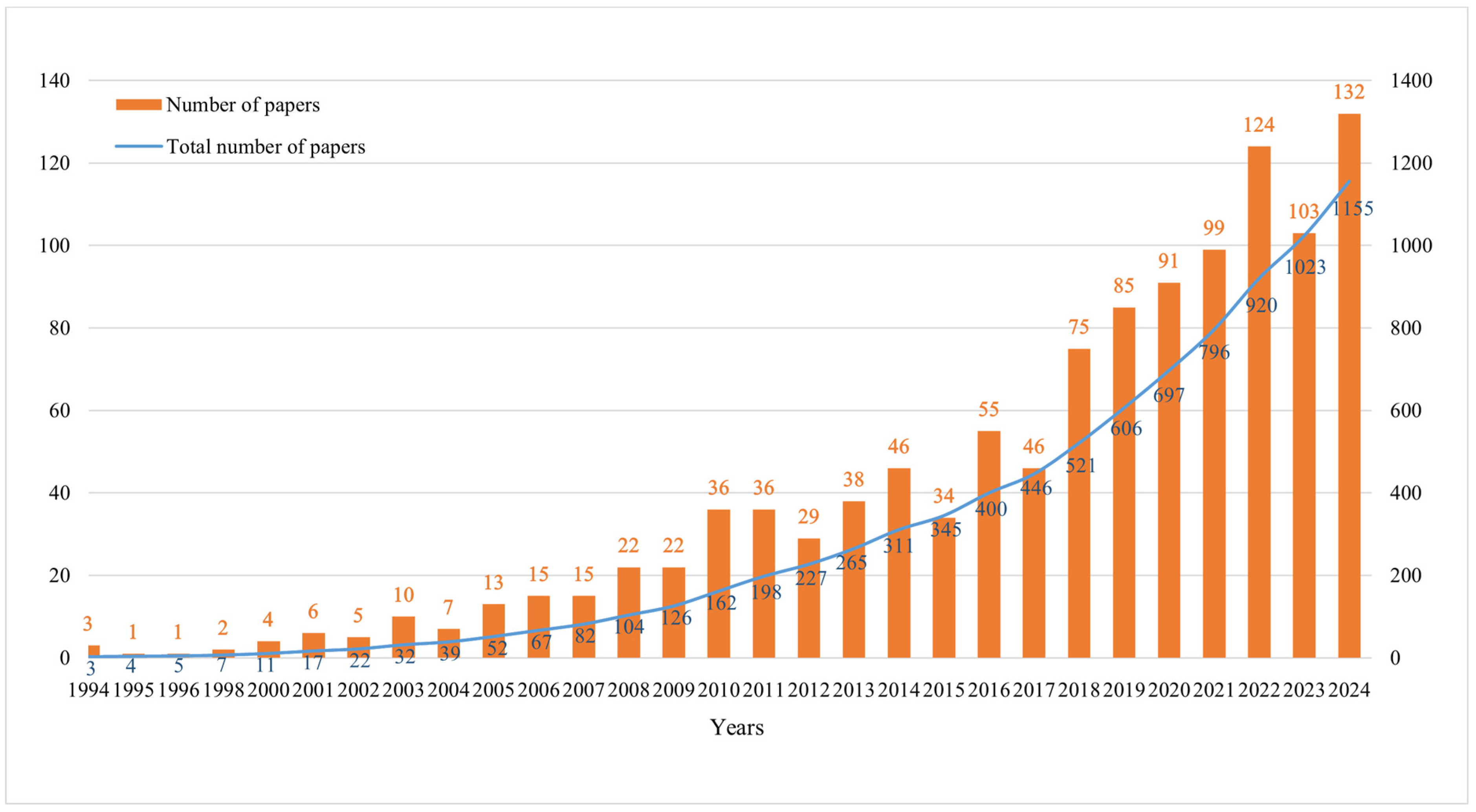
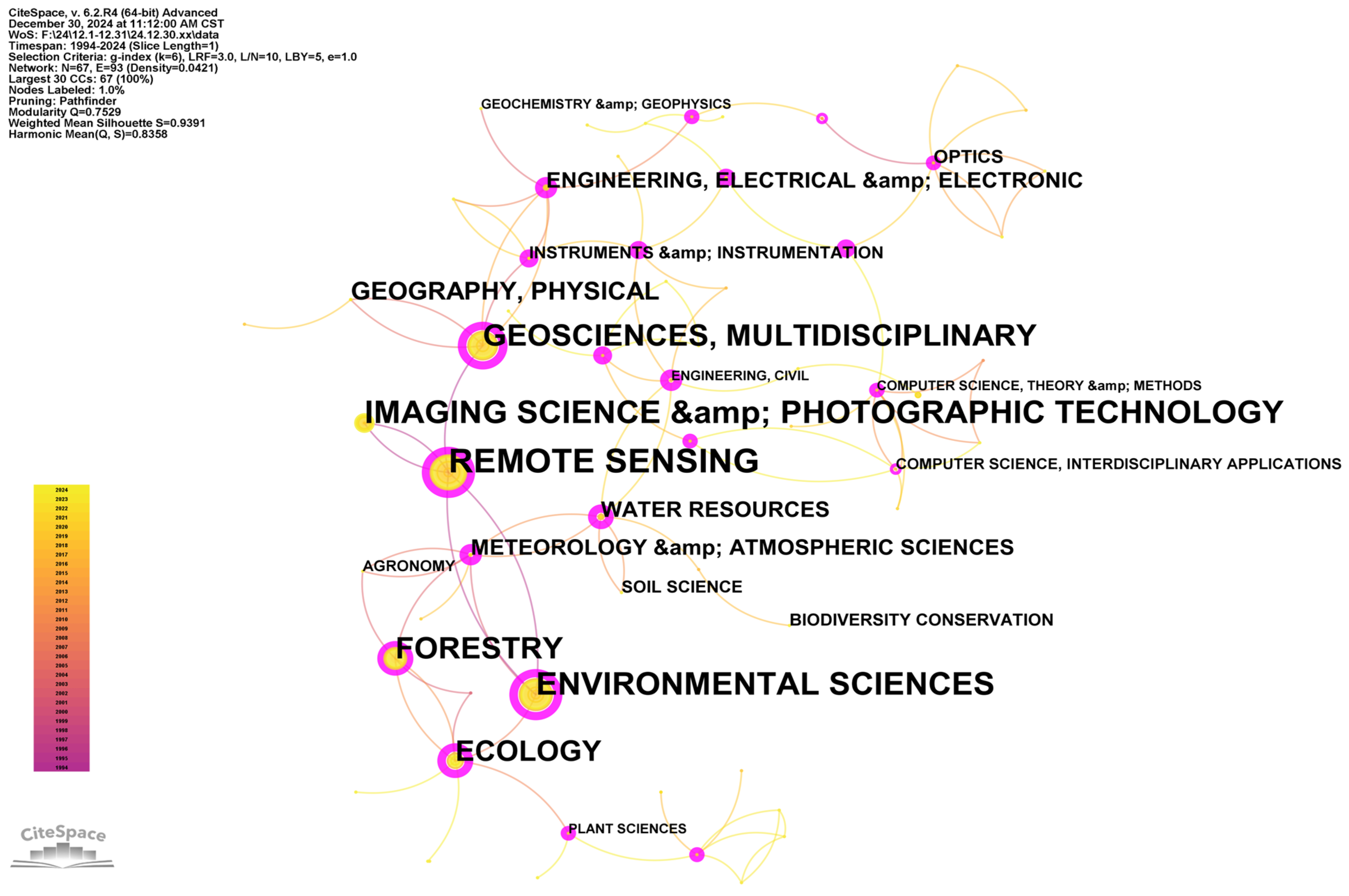

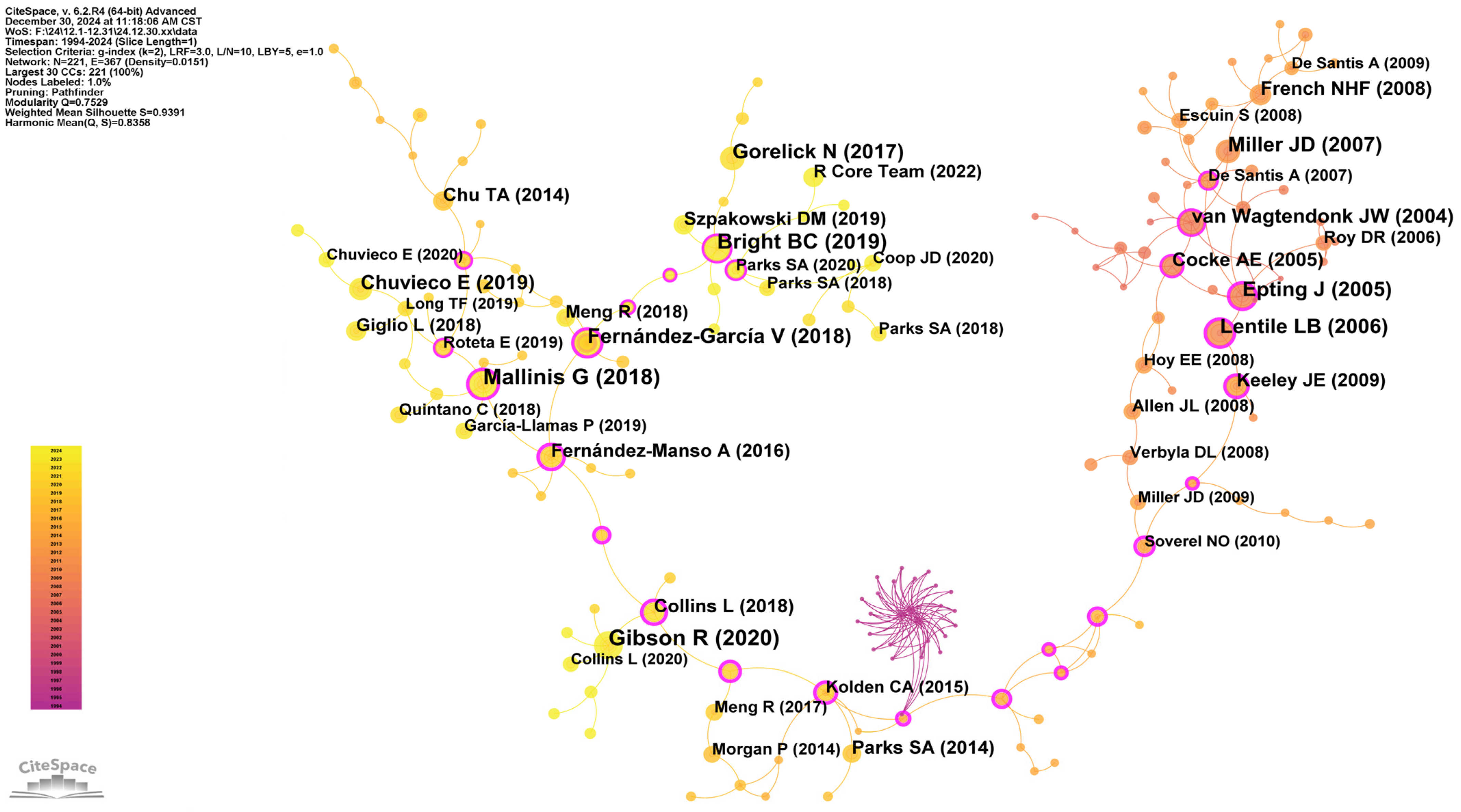
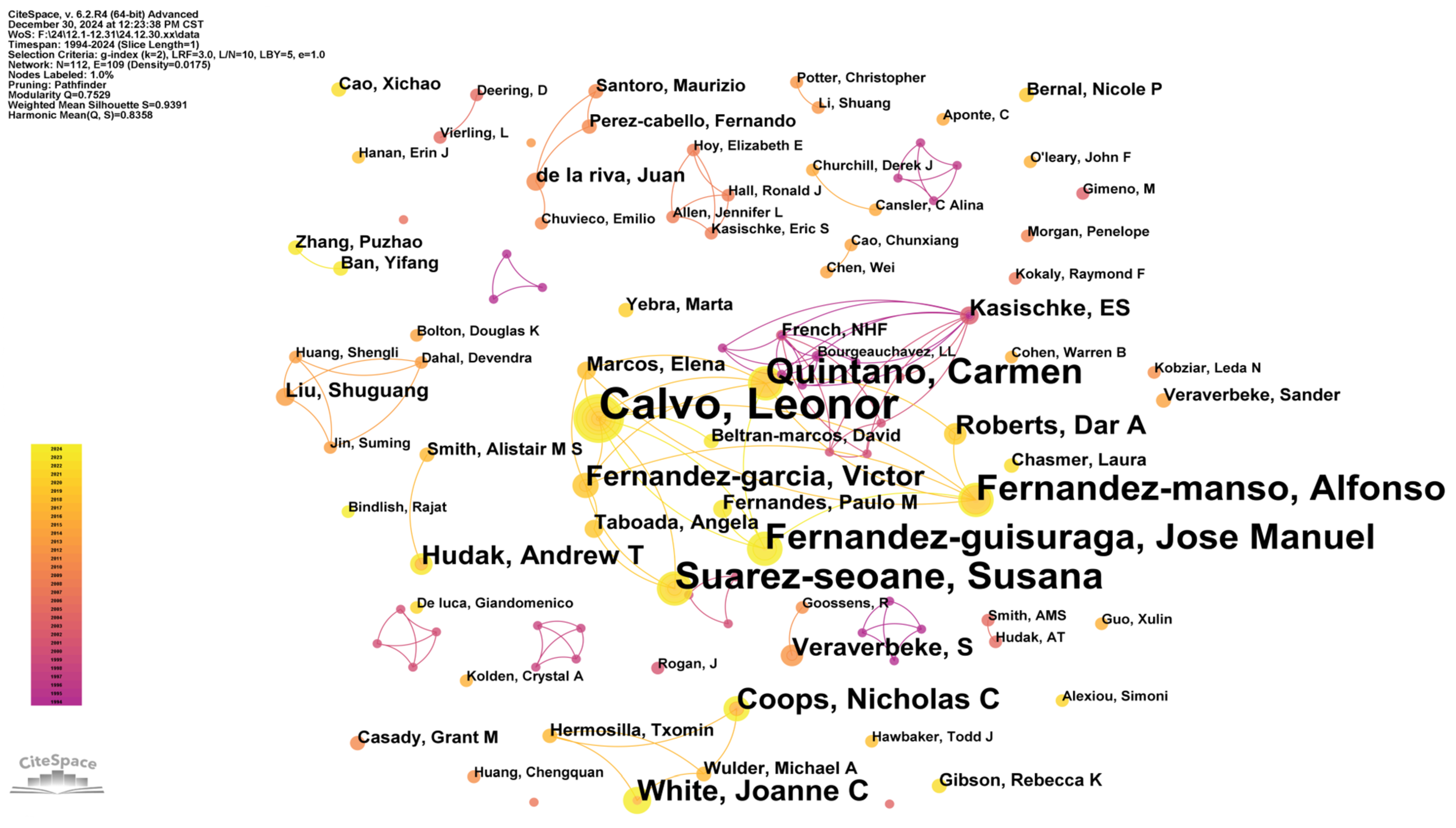
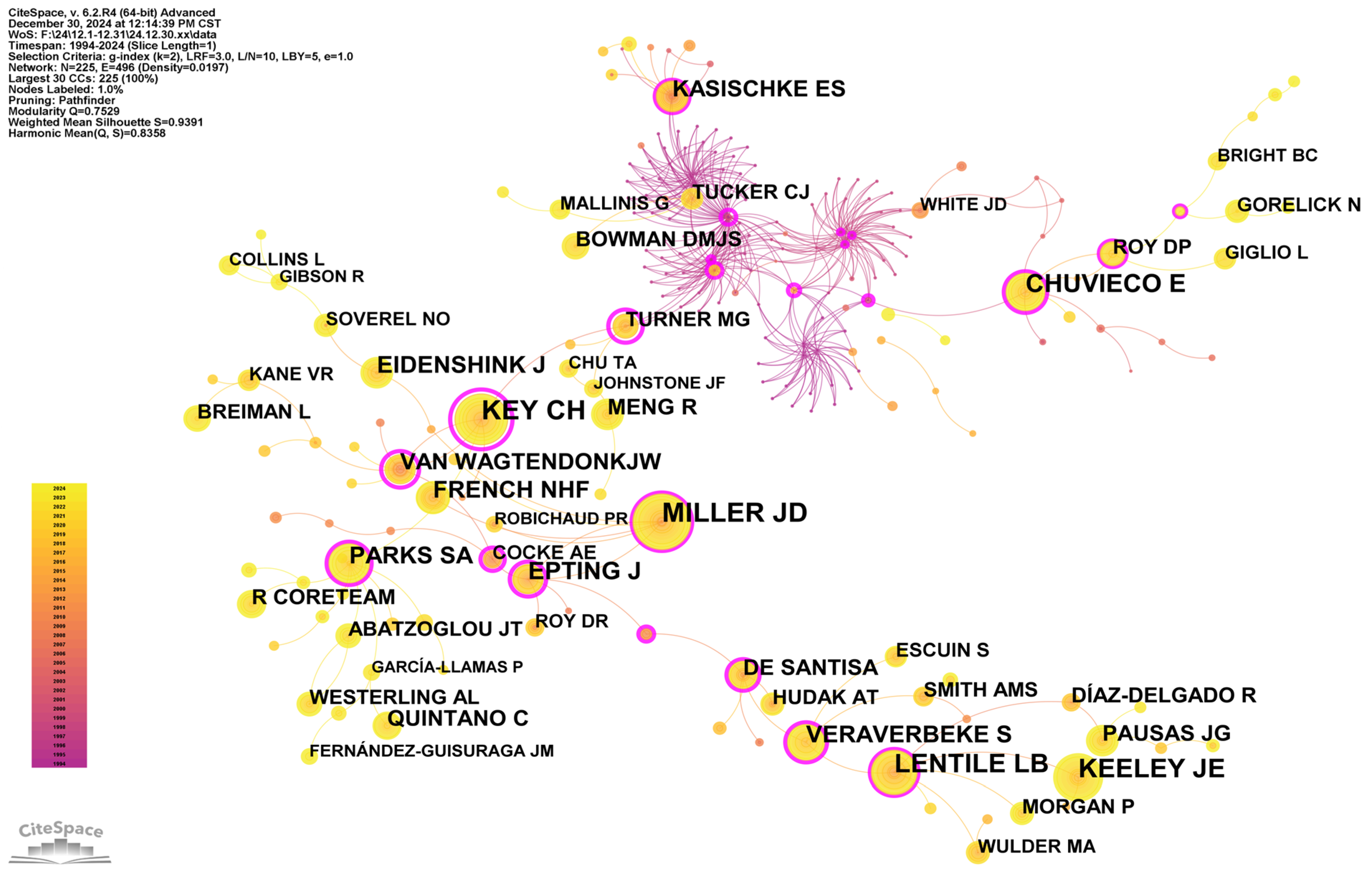
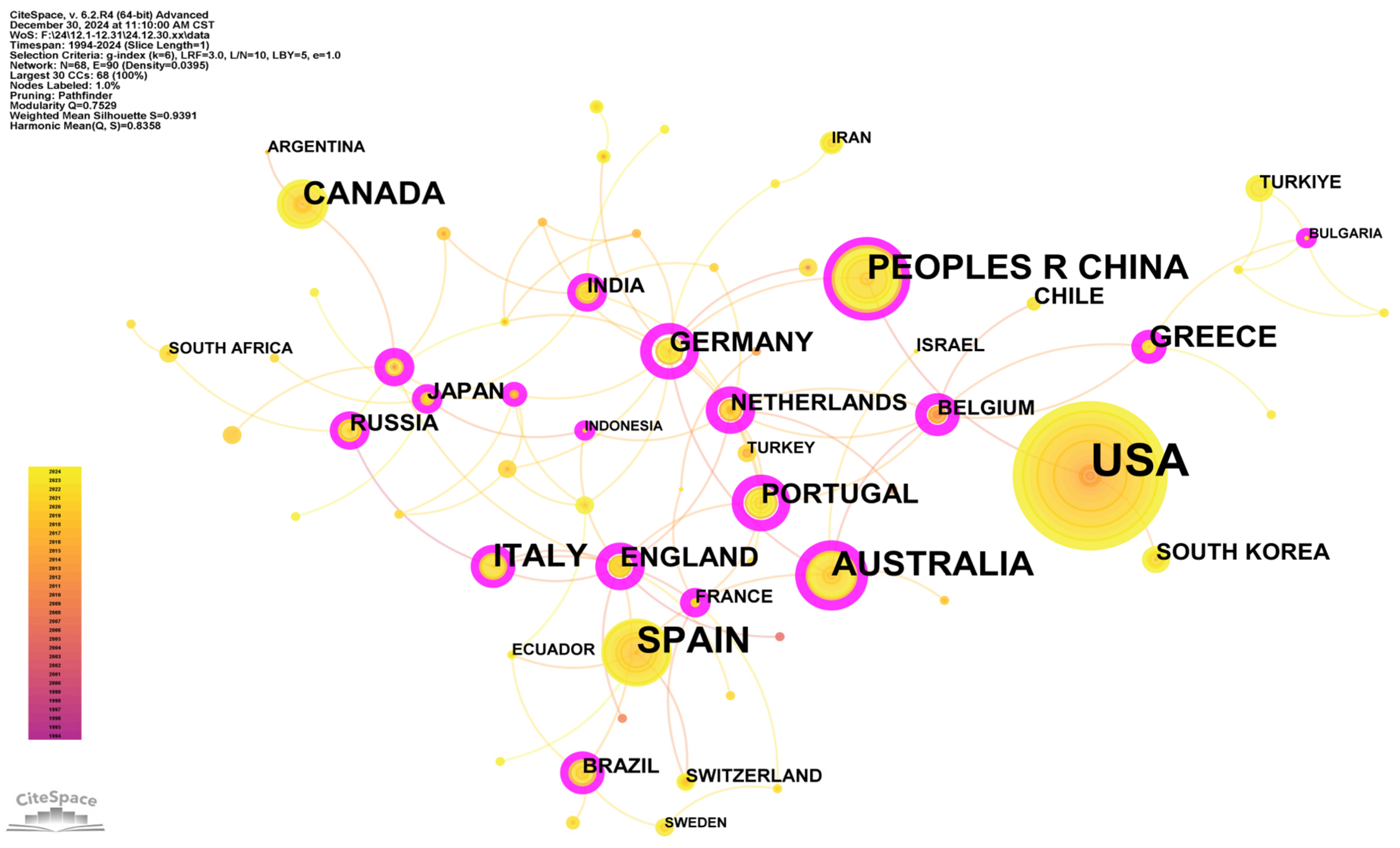

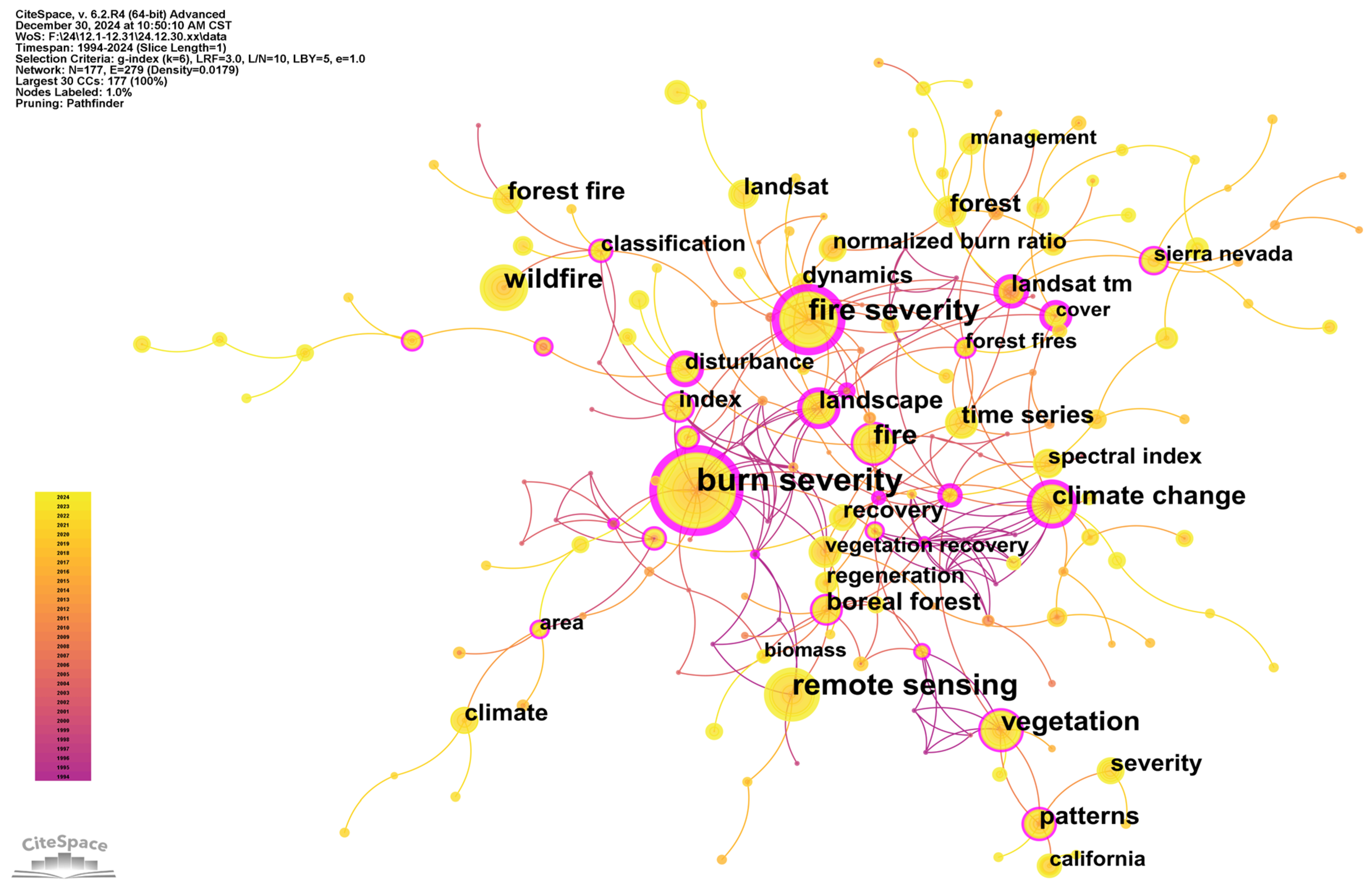

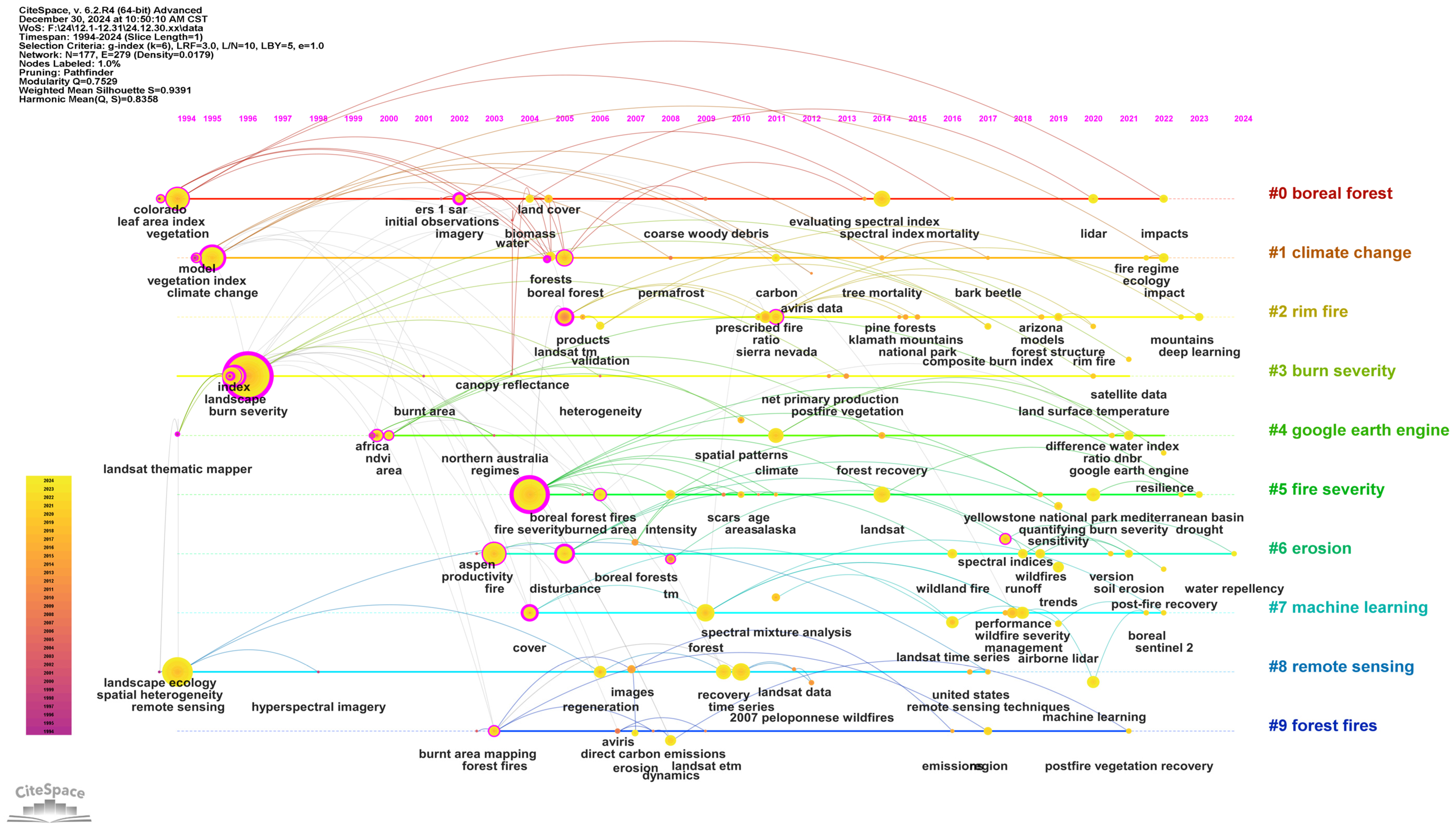
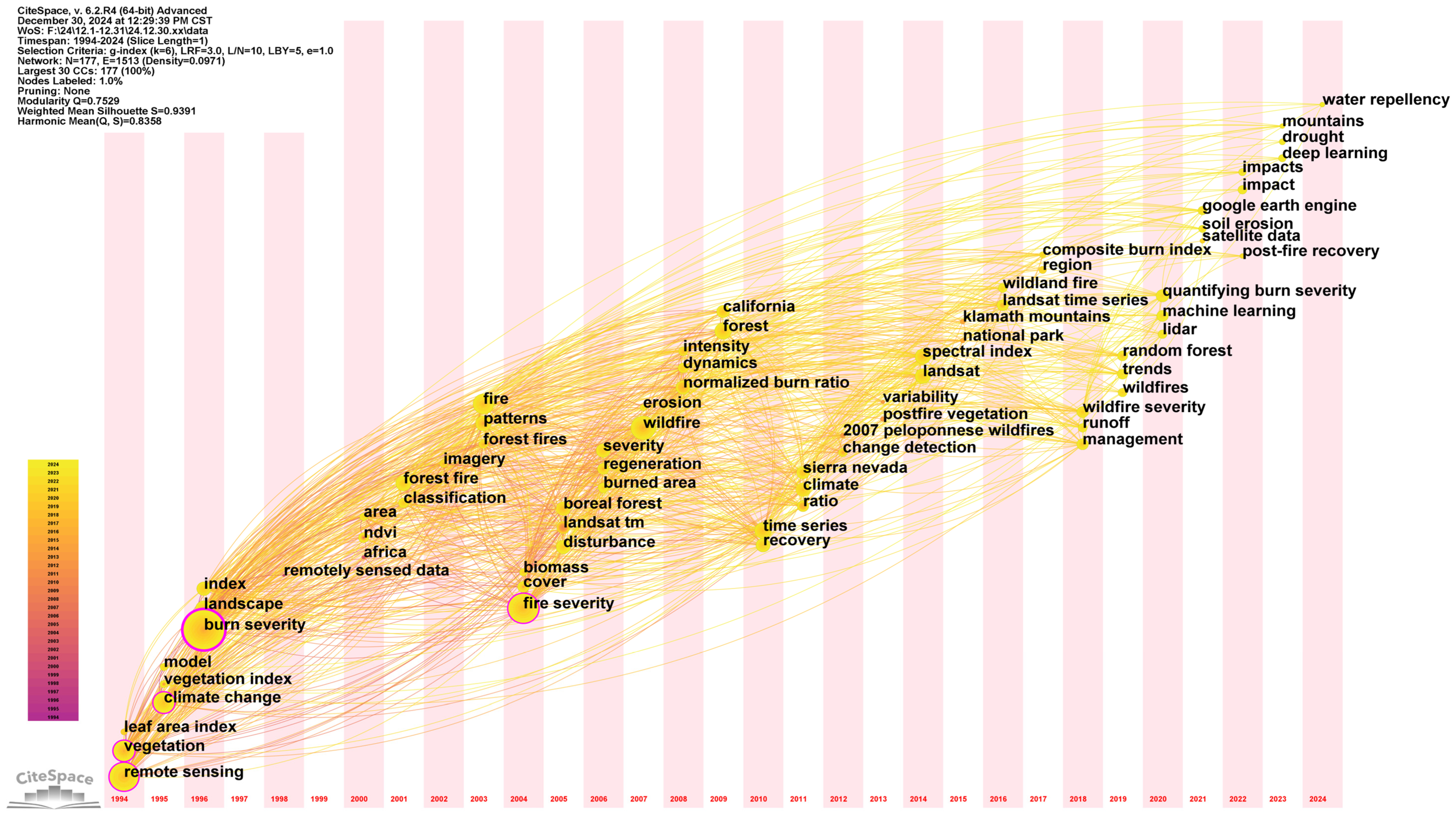
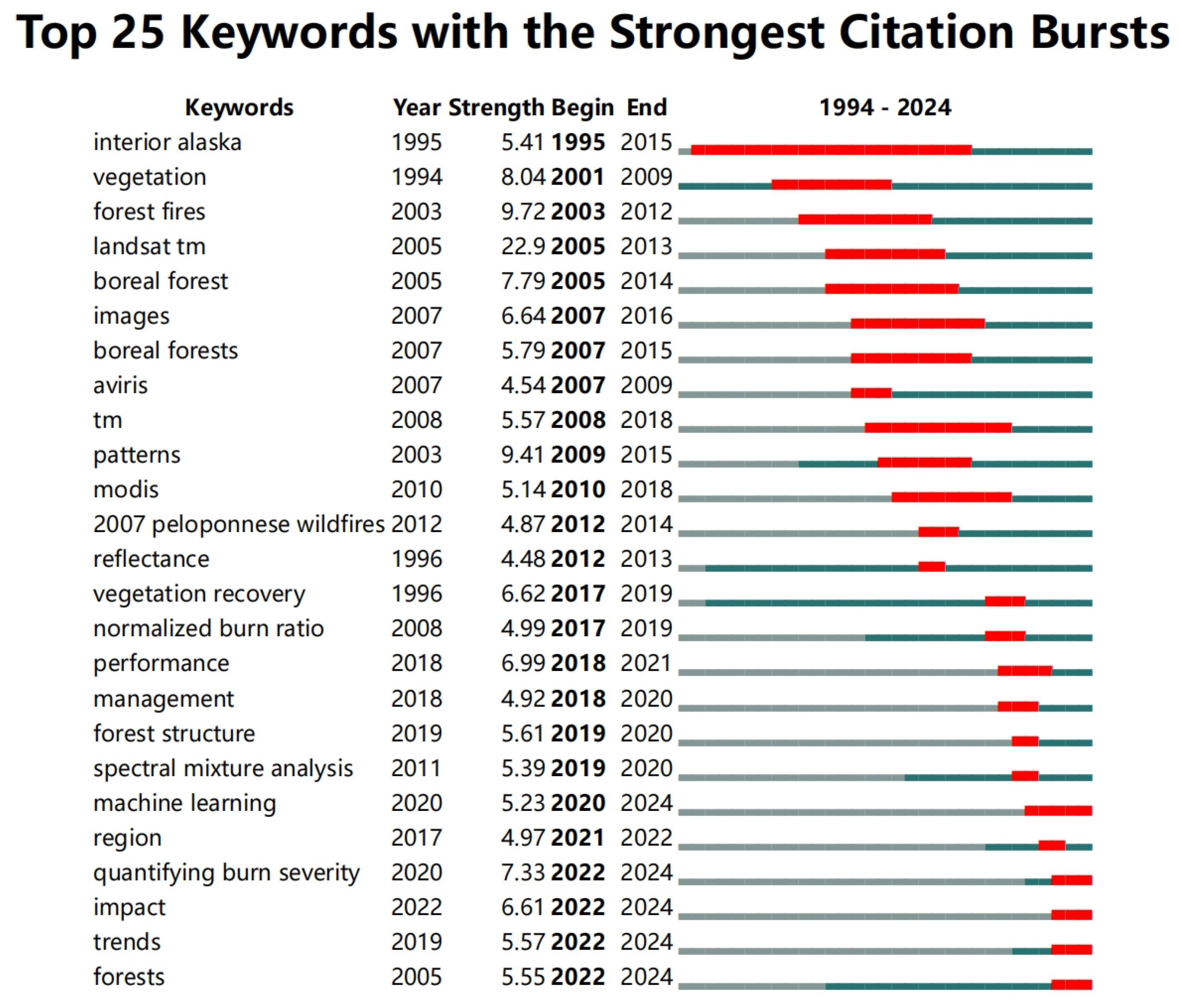
| Parameter | Description | Impact |
|---|---|---|
| g-index (k = 6) | The top 6% of cited literature was selected for each time slice | Filtering low-impact literature to highlight core nodes |
| LRF = 3.0 | Link Retention Factor (LRF), which controls the strength of link retention across time segments | The higher the value, the closer the cross-time connection |
| L/N = 10 | Keep up to 10 links per node | Preventing over-complexity of networks |
| LBY = 5 | The minimum look back years only considers the last 5 years | Focus on recent active research directions |
| E = 1.0 | The weight decay factor for connections between time slices | e = 1 indicates that there is no attenuation, and the weight of the historical connection is the same as the current one |
| Ranking | Subject Area | Year | Frequency | Centrality |
|---|---|---|---|---|
| 1 | REMOTE SENSING | 1994 | 492 | 0.36 |
| 2 | ENVIRONMENTAL SCIENCES | 1994 | 387 | 0.5 |
| 3 | IMAGING SCIENCE AND PHOTOGRAPHIC TECHNOLOGY | 1994 | 359 | 0 |
| 4 | GEOSCIENCES, MULTIDISCIPLINARY | 1994 | 309 | 0.41 |
| 5 | FORESTRY | 1994 | 288 | 0.17 |
| 6 | ECOLOGY | 1994 | 178 | 0.56 |
| 7 | GEOGRAPHY, PHYSICAL | 2000 | 102 | 0.06 |
| 8 | ENGINEERING, ELECTRICAL, AND ELECTRONIC | 2001 | 62 | 0.29 |
| 9 | WATER RESOURCES | 2005 | 56 | 0.53 |
| 10 | METEOROLOGY AND ATMOSPHERIC SCIENCES | 2002 | 55 | 0.46 |
Disclaimer/Publisher’s Note: The statements, opinions and data contained in all publications are solely those of the individual author(s) and contributor(s) and not of MDPI and/or the editor(s). MDPI and/or the editor(s) disclaim responsibility for any injury to people or property resulting from any ideas, methods, instructions or products referred to in the content. |
© 2025 by the authors. Licensee MDPI, Basel, Switzerland. This article is an open access article distributed under the terms and conditions of the Creative Commons Attribution (CC BY) license (https://creativecommons.org/licenses/by/4.0/).
Share and Cite
Sun, M.; Zhang, X.; Jin, R. Visualization of Post-Fire Remote Sensing Using CiteSpace: A Bibliometric Analysis. Forests 2025, 16, 592. https://doi.org/10.3390/f16040592
Sun M, Zhang X, Jin R. Visualization of Post-Fire Remote Sensing Using CiteSpace: A Bibliometric Analysis. Forests. 2025; 16(4):592. https://doi.org/10.3390/f16040592
Chicago/Turabian StyleSun, Mingyue, Xuanrui Zhang, and Ri Jin. 2025. "Visualization of Post-Fire Remote Sensing Using CiteSpace: A Bibliometric Analysis" Forests 16, no. 4: 592. https://doi.org/10.3390/f16040592
APA StyleSun, M., Zhang, X., & Jin, R. (2025). Visualization of Post-Fire Remote Sensing Using CiteSpace: A Bibliometric Analysis. Forests, 16(4), 592. https://doi.org/10.3390/f16040592






